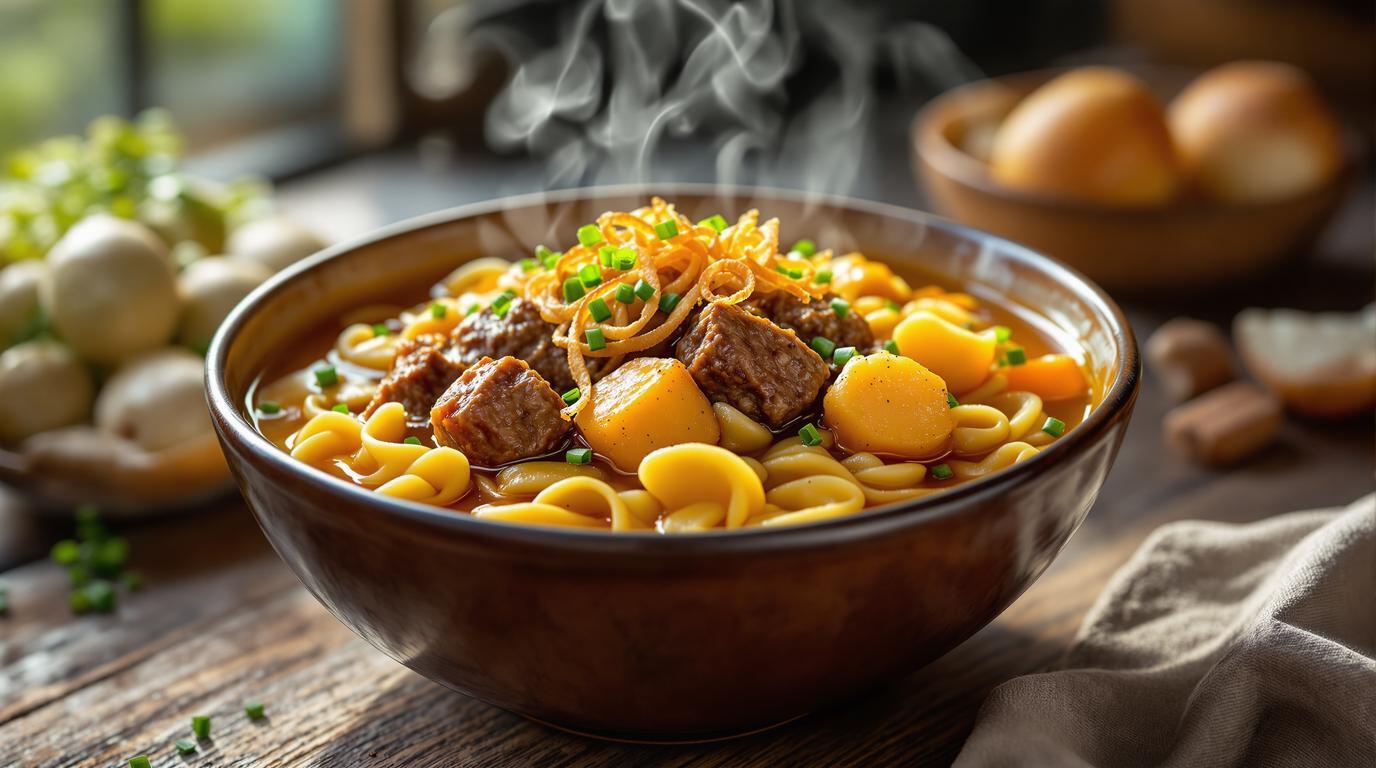There’s something magical about the simplicity of Gaisburger Marsch that brings me back to my earliest days in professional kitchens. Working in Stuttgart, I was introduced to this humble Swabian specialty by an 80-year-old kitchen porter who insisted this hearty beef stew with spätzle was “the only dish worth mastering.” What makes this centuries-old recipe so special isn’t fancy ingredients or complicated techniques – it’s the beautiful marriage of three humble components: tender beef, handmade spätzle, and perfectly cooked potatoes, all united by a rich, bone-infused broth.
The Soul of Swabian Comfort Food
Gaisburger Marsch (literally “march from Gaisburg”) earned its curious name from the neighborhood in Stuttgart where it originated. Legend has it that soldiers would “march” to a particular tavern in Gaisburg just to enjoy this hearty dish, while others say families would bring this nourishing meal to loved ones in prison. Whatever the true origin, this dish represents the ingenious frugality of Swabian cooking, transforming humble ingredients into something truly spectacular.
I’ve made countless versions of this dish over my career, but I always return to the traditional method that honors its roots. The key is patience – allowing the beef to surrender its flavor to the broth while maintaining its tenderness. This isn’t just a recipe; it’s a piece of German culinary heritage that deserves our respect and attention. If you’ve been looking for an introduction to Swabian cuisine, this is where to begin.
The Essential Building Blocks
For the broth and beef:
• 2½ lbs (1.2kg) beef chuck or brisket, in one piece
• 2-3 marrow bones, preferably roasted
• 1 large onion, halved and charred
• 2 carrots, roughly chopped
• 1 celery root (or 3 celery stalks), chopped
• 1 leek, white and light green parts
• 3 juniper berries
• 5 black peppercorns
• 1 bay leaf
• Salt to taste
For the spätzle:
• 2½ cups (300g) all-purpose flour
• 4 large eggs
• 8g salt (about 1½ teaspoons)
• ⅓ cup (100ml) water
For the finish:
• 1½ lbs (650g) waxy potatoes, peeled and cubed
• Crispy fried onions (store-bought or homemade)
• Fresh chives, finely chopped
The Soulful Process
1. Create the backbone broth: Place beef and roasted marrow bones in a large pot. Add the charred onion (this adds remarkable depth), all vegetables, and spices. Cover with 2 quarts (2L) of cold water. Bring to a gentle simmer—never a rolling boil, which clouds the broth. Skim any foam that rises. Simmer gently for about 1½ hours until meat is tender but not falling apart.
2. Prepare the meat: Remove the beef from the broth, let cool slightly, then cut into ½-inch (1.5cm) cubes. Strain the broth, discarding the vegetables (they’ve given their all). Return broth to a clean pot and keep warm.
3. Cook the potatoes: Add potato cubes to the strained broth and simmer until just tender, about 15-20 minutes. They should hold their shape but yield easily to a fork.
4. Craft the spätzle: While potatoes cook, prepare the spätzle batter by mixing flour, eggs, salt, and water until you achieve a sticky, elastic consistency that slowly drips from the spoon. The batter should not be runny – it needs to hold its shape briefly. Using a spätzle maker, colander, or simply cutting small pieces from a board, drop the batter into boiling salted water. Cook for 2-3 minutes until they float. Drain well.
Chef’s Note: For truly luxurious “Sunday-style” spätzle, omit the water and use 6 eggs instead of 4. The result is a richer, more decadent noodle that elevates this humble dish to celebratory status. My grandmother swore by this technique for special occasions.
The Assembly and Presentation
The traditional serving method is what makes Gaisburger Marsch special. In each bowl, layer:
1. A generous portion of spätzle at the bottom
2. Cubed beef arranged over the spätzle
3. Potato cubes scattered around
4. Ladle the hot broth over everything
5. Top with crispy fried onions and fresh chives
This arrangement allows each component to maintain its integrity while still absorbing the flavorful broth. The result is a dish that’s simultaneously a stew, a soup, and a complete meal.
If you’re seeking similar comfort food experiences, consider trying this slow-cooked Greek Kleftiko or a hearty Cajun jambalaya which shares that wonderful one-pot philosophy.
The beauty of Gaisburger Marsch lies in its humble ingredients transformed through careful technique. Don’t have marrow bones? Use a high-quality beef stock enriched with a tablespoon of butter. Can’t make spätzle from scratch? In a pinch, egg noodles will work, though I encourage you to try the real thing at least once—perhaps even using my grandmother’s ice water trick to perfect the dough.
For a modern twist, consider adding a drizzle of my Latin 3-ingredient marinade to the beef before cooking, or pairing with a velvety vegetable side dish. But truth be told, this classic needs little improvement – it’s stood the test of time for good reason.
As we say in professional kitchens: respect the classics first, then innovate. This Gaisburger Marsch respects generations of Swabian grandmothers who knew that comfort food isn’t about complexity – it’s about care, patience, and understanding how humble ingredients can create something truly extraordinary.
